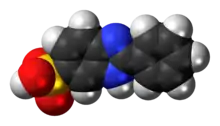Ensulizole
Ensulizole (INN;[1] also known as phenylbenzimidazole sulfonic acid) is a common sunscreen agent. In 1999, the United States Food and Drug Administration regulated that the name ensulizole be used on sunscreen labels in the United States. Ensulizole is primarily a UVB protecting agent providing only minimal UVA protection. The scope of UVB is 290 to 340 nanometers whereas the UVA range is 320 to 400 nanometers.[2] For better UVA protection, it must be paired with avobenzone, titanium dioxide, or zinc oxide; outside of the United States it can also be paired with a UV absorber of the Tinosorb or Mexoryl types. Because ensulizole is water-soluble, it has the characteristic of feeling lighter on skin. As such, it is often used in sunscreen lotions or moisturizers whose aesthetic goal is a non-greasy finish.[3] The free acid is poorly soluble in water, so it is only used as its soluble salts.[4]
 | |
 | |
| Names | |
|---|---|
| IUPAC name
2-Phenyl-3H-benzimidazole-5-sulfonic acid | |
| Identifiers | |
3D model (JSmol) |
|
| ChemSpider | |
| ECHA InfoCard | 100.044.078 |
| KEGG | |
PubChem CID |
|
| UNII | |
CompTox Dashboard (EPA) |
|
| |
| |
| Properties | |
| C13H10N2O3S | |
| Molar mass | 274.29 g·mol−1 |
| Hazards | |
| Safety data sheet | Cole Parmer Material Safety Data Sheet |
Except where otherwise noted, data are given for materials in their standard state (at 25 °C [77 °F], 100 kPa). | |
| Infobox references | |